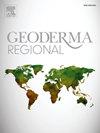以保护性农业为基础的谷物系统中早期土壤有机碳的稳定性
IF 3.1
2区 农林科学
Q2 SOIL SCIENCE
引用次数: 0
摘要
在南亚,由于土壤有机碳耗竭、生产力停滞不前以及温室气体(一氧化二氮、甲烷和二氧化碳)排放对环境造成的不利影响,传统耕作和投入密集型谷物种植系统(如水稻-大米和水稻-小麦)的可持续性受到了质疑。在此背景下,2009 年在印度的三个地点(卡纳尔、巴特那和 Aduthurai)和孟加拉国的一个地点(加济布尔)启动了一项长期田间试验,以评估反映当前和未来多样化作物轮作和保护性农业(CA)实践的四种情景(S):S1 - 采用传统方法的双谷物轮作;S2 - 部分采用保护性耕作的双谷物加豆科植物轮作;S3 - 采用全面保护性耕作的双谷物加豆科植物轮作;S4 - 采用全面保护性耕作的未来多样化谷物豆科植物轮作。本研究深入探讨了所有方案和地点的土壤有机碳动态和稳定性。在两个作物周期后,我们分别从 0-15 厘米和 15-30 厘米深处采集了土壤样本。我们分析了沃克利-布莱克碳(WBC)、总有机碳(TOC)以及不同氧化性的各种碳库,确定了基于 CA 的方案下稳定的碳量,并确定了南亚碳经济的最佳系统。平均而言,主动碳库、被动碳库、总有机碳库和水生生物碳库依次为除加齐布尔外,所有地点的顺序均为 S3 > S4 > S2 > S1。CA方法以每年1.7%的速度稳定了土壤有机碳中的碳输入量,在S4(11.7%)> S3(10.6%)> S2(7.8%)下观察到更大的稳定性,与地点无关。与水稻-小麦种植区(6.7%)相比,水稻-水稻种植区的碳稳定率更高(13.4%)。稳定碳的很大一部分(63%)被分配到了 S2、S3 和 S4 土壤中的被动碳库,这突出表明了 CA 提高碳稳定性的潜力。利用线性指数技术,我们发现 S3 和 S4 都有利于提高碳稳定性、产量可持续性和环境共同效益。因此,建议在包括印度和孟加拉国在内的南亚主要双谷物种植区采用具有最佳管理实践(S3)的完整 CA 系统和具有作物多样化(S4)的最佳管理实践,以实现作物的可持续生产。本文章由计算机程序翻译,如有差异,请以英文原文为准。
Early-stage soil organic carbon stabilization in conservation agriculture-based cereal systems
In South Asia, the sustainability of conventional tillage and input-intensive cereal-based cropping systems (such as rice-rice and rice-wheat) is under scrutiny due to soil organic carbon depletion, stagnant productivity, and adverse environmental impacts stemming from greenhouse gas emissions (N2O, CH4, and CO2). Against this backdrop, a long-term field experiment was initiated in 2009 at three sites in India (Karnal, Patna, and Aduthurai) and one site in Bangladesh (Gazipur) to assess four scenarios (S) reflecting current and future diversified crop rotations and conservation agriculture (CA) practices: S1 - double cereal rotation with conventional practices; S2 - double cereal plus legume rotation with partial CA; S3 - double cereal plus legume rotation with full CA; and S4 - futuristic diversified cereal-legume rotations with full CA. This study delved into the dynamics and stabilization of soil organic carbon across all scenarios and sites. Replicated soil samples were collected from depths of 0–15 cm and 15–30 cm after two crop cycles. We analyzed Walkley-Black carbon (WBC), total organic carbon (TOC), and various carbon pools with different oxidizability, determining the amount of carbon stabilized under CA-based scenarios and identifying optimal systems for carbon economy in South Asia. On average, active and passive carbon pools, TOC, and WBC stocks followed the order: S4 > S3 > S2 > S1 at all sites, except Gazipur, where the order was S3 > S4 > S2 > S1. CA practices stabilized applied carbon inputs to soil organic carbon at an annual rate of 1.7 %, with greater stabilization observed under S4 (11.7 %) > S3 (10.6 %) > S2 (7.8 %), regardless of location. Rice-rice sites exhibited a higher carbon stabilization rate (13.4 %) compared to rice-wheat sites (6.7 %). A significant proportion of stabilized carbon (63 %) was allocated to passive pools in soils under S2, S3, and S4, highlighting CA's potential to enhance carbon stability. Using a linear indexing technique, we identified that both S3 and S4 are conducive to better carbon stabilization, yield sustainability, and environmental co-benefits. Consequently, full CA systems with best management practices (S3) and best management practices with crop diversification (S4) are recommended for sustainable crop production in the major double cereal growing regions of South Asia, including India and Bangladesh.
求助全文
通过发布文献求助,成功后即可免费获取论文全文。
去求助
来源期刊

Geoderma Regional
Agricultural and Biological Sciences-Soil Science
CiteScore
6.10
自引率
7.30%
发文量
122
审稿时长
76 days
期刊介绍:
Global issues require studies and solutions on national and regional levels. Geoderma Regional focuses on studies that increase understanding and advance our scientific knowledge of soils in all regions of the world. The journal embraces every aspect of soil science and welcomes reviews of regional progress.
 求助内容:
求助内容: 应助结果提醒方式:
应助结果提醒方式:


